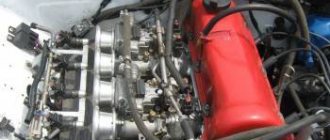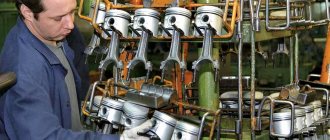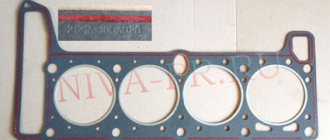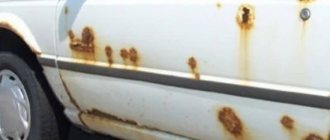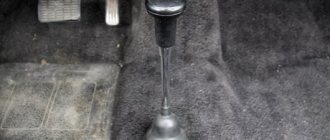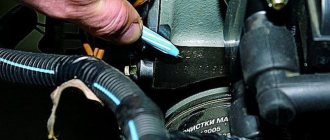Every year the amount of electrical equipment on a car increases. And although, thanks to the miniaturization of electronic components, it is still possible to keep this entire mass on a 12-volt on-board network, the situation in the medium term may become critical. But even today, a lot depends on the wiring and, of course, on the quality of the mass, which has a direct impact on the accuracy of the functioning of sensors, sensors, controllers and other components of electrical equipment.
The electrical mass, as is known, is part of the on-board electrical network, connecting the battery and the vehicle body, the latter being a conditional return segment forming a closed autonomous system.
This means that the car body acts as a conductor of electrons with a negative charge. But the capabilities of the standard mass do not always satisfy the increased load on the network. That is why they de-minus the engine, connecting the most powerful consumers to additional mass.
What is engine demining?
Structurally, the car has a developed electrical system, in which the serviceability and accuracy of the controllers, various sensors and many other electrical devices depend on the mass. The electrical ground (minus) is connected from the battery to the car body. The body is conventionally a return wire, forming a closed electrical circuit.
The movement of electrons along the circuit is initiated by the battery, and the body acts as a conductor of negative charge for return via the negative terminal. For this reason, the metal body of a car is called car body. In this case, engine demining should be understood as a number of improvements that involve additional connection of the most powerful consumers of electricity in the car to ground.
Causes and symptoms of poor engine grounding
Engine malfunction may be caused by:
- Loose, rusty, or damaged ground terminals or wires
- Weak, damaged or corroded battery ground terminal
- Poorly installed or repaired components
Symptoms of a poor motor ground may include:
- Dim lights
- Flickering lights
- Electrical devices operate erratically
- Faulty fuel pump
- A slipping or burnt A/C compressor clutch
- Intermittent sensor failure
- Throttle or transmission cables are damaged
- Hard start
- Low battery
Why do they do the de-mining?
During the operation of the car, you may encounter the fact that the electrical on-board network literally “sags,” especially at times of peak loads (simultaneous activation of the dimensions, low and high beam headlights, various heated mirrors and windows in parallel with the use of the air conditioning system, electric windows, powerful acoustics and other devices).
Also, voltage dips can occur for no apparent reason, affecting the stability of the internal combustion engine, its ignition system, ECU, sensors, servos and other electrical devices. This can happen if oxidation has occurred in the place where the negative terminal is normally attached to the body, the contact has broken down, or corrosion has appeared. The automobile electrical network naturally begins to operate unstably.
In the first case, additional demining of the engine is often necessary due to the fact that the car body is old, the standard place for attaching the mass has become unusable, etc. Regarding improvements and tuning, there is an opinion that additional de-mining allows a more even distribution of electricity in the vehicle’s on-board network compared to using the standard negative terminal.
The main goals of the de-minus
Many car owners have probably repeatedly observed such a phenomenon as “sagging” of the on-board electrical network at the moments of its highest load, while simultaneously connecting several devices that require current consumption (for example, a climate system, a multimedia center, electric heated seats). Such short-term failures are fraught with many unpleasant surprises, including failure of the on-board computer.
But they can also be observed without visible and obvious reasons, worsening the performance of the power unit, sensors, ignition system, servos and the same electronic control unit. Such failures usually occur due to weakening of the standard mass, in the event of oxidation or destruction of contacts. In this case, the stability of the functioning of the on-board electrical network will be disrupted.
The situation will be corrected by demining the engine, which in this case will turn out to be an additional device that, in case of problems with the main one, will take on the role of a standard minus. As a rule, owners of frankly old cars, the body of which is far from ideal, are forced to take such a step.
The second reason why engine demining is needed, although it sounds more exotic, is in fact also quite rational: it is performed by apologists for tuning the power unit. In their opinion, the presence of additional mass makes it possible to reduce the load on the on-board electrical network, distributing it more evenly compared to the use of a single standard mass.
Additional Weight: Benefits
Engine demining for the purpose of improvement has both supporters and opponents of this method. Skeptics consider this solution a waste of time and money, citing the fact that standard solutions in the car are quite sufficient, the cross-section of the factory wires is sufficient, each sensor has its own separate negative ground (sensor ground), etc.
The main argument among those who have already implemented the procedure is the stability of spark formation and operation of the entire ignition system as a result of the most efficient and reliable mass in the car. It is also claimed that the mass becomes even for all devices that consume electricity. Such uniform distribution cannot be achieved with standard mass, even if the terminals are cleaned regularly. The list of main advantages of power engine demining includes:
This modification makes it easier to start the car and increases the stability of speed in idle mode (the speed does not fluctuate). It was also noted that after the diesel or gasoline engine has been de-energized, headlights begin to shine brighter, increasing the comfort and safety of movement at night. Additionally, it is worth noting that after de-mining, interference and interference are minimized or completely eliminated, and music from the media and radio in the car’s speaker system begins to play clearer. Another advantage is increased safety for electrical equipment in the event that the standard ground wire breaks or its attachment to the body is destroyed.
DISMINUS! Guys, explain!
MITSUBISHI CRAZY CD5W
tell me what it means. if it's not difficult.
yeah, tell me too.
MITSUBISHI CRAZY CD5W
MITSUBISHI CRAZY CD5W
I know this from the category, but I can’t explain it, in general, approximately the following applies to audio systems: it’s better to hook all system components, such as an amplifier, radio, etc., to a common ground; it’s best to pull the ground directly to the battery, if you just hook it to ground, for example, minus the wuxia trunk wing and the radio to the screw to the metal behind the panel, then ground loops appear and a so-called potential difference arises, hence the interference, interference, hissing in the speakers. in general something like this. The same thing can happen to the sensors. although in theory they are all sitting on the engine. It's hard to judge something you haven't seen. need to look. think
How is this possible? Explain, please, otherwise it seems like I’ve been taught the wrong thing for many years.
MITSUBISHI CRAZY CD5W
Well, in the sense of minus the radio. or did you just decide to fuck around? Or you don’t know what ground loops are. Please describe in more detail what you want to explain, I’ll explain it as best I can
Of course, if, as a result of the competent intervention of super specialists, all unnecessary wires are eliminated, then there may be problems, because The motor rests on rubber mounts.
As for the potential difference, etc. You could pick up the rifle and measure the voltage in different areas.
I’ll tell you a secret that sensors usually have their own separate ground. (Sensor ground). And it is not common with the mass of the body. (just for the accuracy of the readings) The ECU has its own power supply for this.
And of course, it makes sense to throw in the wire. for ignition and generator. I don’t see much point in entangling the entire motor.
I’ll tell you a secret that sensors usually have their own separate ground. (Sensor ground). And it is not common with the mass of the body. (just for the accuracy of the readings) The ECU has its own power supply for this.
And of course, it makes sense to throw in the wire. for ignition and generator. I don’t see much point in entangling the entire motor.
Everything is short and clear. It’s immediately obvious that the person is on topic. and there's nothing more to add
Well, that’s how it is.. like, how the contours are formed there.
How to de-minus the engine yourself
The procedure involves running additional wires to ground from the main sources of current consumption.
For most cars, the minus is carried out from 4-6 sources: It is worth adding that you can purchase both ready-made solutions on sale and do the engine demining yourself. For manufacturing you will need a copper cable, heat shrink tubing and terminals. The length of the cable and the number of terminals will depend on how many devices are planned to be grounded to the body (connected to ground). After cutting the cable, you need to crimp the terminals and apply heat shrink in those places where the cable is exposed to connect to the terminal. The final stage will be the installation of the manufactured wires in the engine compartment of the car.
How does the engine start button work? Available options and solutions for installing the starter button yourself. How to install the engine start button yourself.
Signs of malfunction or breakdown of the high-voltage spark plug wire of the ignition system. How to check car armored wires with your own hands.
The starter clicks and/or buzzes, but the engine does not turn over. The main causes of starter failures, diagnosing and troubleshooting them yourself.
How to quickly start the engine with a discharged battery. Features and advantages of using an autonomous battery charger. Tips for choosing a booster.
Conditions for proper storage of a car battery. Removing, inspecting and preparing the battery. How to preserve your battery without regular recharging.
Basic methods for repairing a cracked engine block. Crack detection, repair by welding, riveting or applying an epoxy layer.
Source
How to do the de-mining yourself
From the point of view of the law, installing additional weight is a completely legal procedure, since we are not talking about changing the design of the car here. Physically, demining means connecting the main electrical consumers to ground using additional wires. As a rule, the engine demining scheme involves powering 5-6 sources to ground:
- starter;
- generator;
- automatic transmission;
- the power unit itself (two or more points are recommended);
- part of the body remote from the battery.
To achieve maximum effect, demining requires taking into account the following wiring requirements:
- The wires are made of high-quality copper, the impurity content is minimal, the flexibility of the wires is high. The use of wires made from copper alloys or none of them is not recommended;
- the cross-section of the wires should be large - this will increase their conductivity, reducing heating and the tendency to leaks as a result of interference;
- The insulation of the wires must correspond to the quality of the material, be strong and at the same time flexible, be able to withstand mechanical stress and temperature fluctuations (this mode is typical for the engine compartment, especially at subzero temperatures).
Do-it-yourself demining is a simple procedure. You will need to purchase the cable itself (having previously calculated the required length, summing up the sections for each consumer), terminals, and heat-shrinkable tubing.
We cut the wires, crimp the terminals and place them in the places where the negative wire is attached to each of the consumers, having previously used heat shrink. We are looking for routes for laying wires to the negative terminal of the battery - preferably in such a way that they do not heat up or rub.
All that remains is to connect everything to the battery. To do this, you can use a strip, preferably also copper, drill holes in it for the wires and tighten them with bolts. The bar is also connected to the negative terminal of the battery using a bolted connection.
Where is the ECU ground located?
The ECU mass is usually arranged like this. Separate ground wires are removed from the ECU connector and connected to the engine via the starter mounting bolt. Ground wires are usually black.
In the photo, the thick wire is from the battery, and the thin wires are from the ECU and speed sensor
Everything is simple and reliable. But in reality, over time, the voltage begins to drop in this section of the circuit, slowly but surely, disrupting the operation of the system.
Therefore, this unit must be periodically checked and maintained. We will look at how to do this further.
Why is it important to find and correct a bad ground in a car?
A poor engine ground can ultimately prevent the battery from charging properly, receiving signals from the computer correctly, causing the headlights to glow abnormally, causing starting problems and other problems.
Moreover, poor motor grounding can also cause damage. If too much current tries to find the correct ground without success, it will take the easy path through transmission components, transmission cable, throttle cable, wheel bearings, causing severe damage to these and other components.
Whenever you see signs of electrical problems, check the motor ground.
The diagnostic tests described here are simple procedures that you can perform using a digital multimeter. And they'll save you time and money in minutes.
Weight between engine and body
Line “31”, popularly called “ground”, “minus” or “negative circuit”, is very important for a car. And not only for electrical equipment, but also for many other systems, including the engine or automatic transmission.
Almost all cars have a single-wire on-board network system and the role of the “minus” in this circuit is played by the metal parts of the body. This greatly reduces the number of wires and reduces the cost of the car.
It turns out that all participants in this chain have their own connection to the body - instrument panel, headlights, ECU, engine, etc.
Despite the visual integrity of these connections, over time, due to oxidation and corrosion, the contact slowly and imperceptibly deteriorates, which leads to voltage drops when powerful consumers are turned on or disruption of the system.
I would divide the mass connections into main and local. Let's say that the connection of the head light masses is local and if this connection is disrupted, only the head light will suffer. But if the ground contact from the battery to the body is broken, the entire on-board network will suffer, and this may cause problems in the operation of the engine and other important components and assemblies.
This is how the voltage of the on-board network with problematic masses looks like on the diagnostic graphs
And here is the graph after mass prevention of battery - engine - body
Therefore, a reliable engine-body mass is very important for the proper and trouble-free operation of the entire vehicle.
In general, the ground chain must be maintained in perfect condition. It's like an axiom.
Next, let's look at where the engine-body mass is located and how to check it.
Weight in the VAZ 2114: location, possible problems and their solution
The vehicle's electrical network is connected to a common “minus”, or mass, which is the entire body. That is, the body as a mass on the VAZ 2114 represents a single source of negative charge. And the source of negative charge is the connection between the case and the negative terminal of the battery.
If the wires connected from the electrical network to ground oxidize (come off), problems arise with the electronics, engine or control system. In case of typical “mass” faults, for example, “blinking” of the rear lights instead of turning on the turn signal or poor cranking of the starter, first check the condition of the wires connected to ground and contact points.
Where is the mass of the ecu for the VAZ 2114
The first ground pin from the ECU on cars with a 1.5 engine is located under the instruments on the power steering shaft mount. The second terminal is located under the instrument panel, next to the heater motor, on the left side of the heater housing.
On cars with a 1.6 engine, the first terminal (mass of the VAZ 2114 ECU) is located inside the dashboard, on the left, above the relay/fuse block, under the sound insulation.
The second terminal is located above the left screen of the center console of the instrument panel on a welded stud (fastened with an M6 nut).
All studs have no corrosion protection other than factory paint. When the paint comes off, the stud rusts. Pay attention to the condition of the stud and treat it with protective lubricant.
Where is the ECM mass located?
The ECM ground is located on the plug mounts on the right side of the 1.5 engine head. On the 1.6 engine, the mass on the VAZ 2114 engine is placed on a welded pin connecting the metal frame of the central panel and the floor tunnel.
Where is the battery mass located?
The battery mass consists of two wires of different thicknesses. A thick wire extends from the battery negative to the engine housing. A thin wire is attached to the housing next to the battery.
Where is the mass of the engine - battery - body
On most cars, the engine-body mass has a primitive appearance and is made of two pieces of cable connected together by crimping on the negative terminal of the battery
This crimp connects two wires. One goes to the engine and is secured with the starter mounting nut...
...and the second one on the body in the area of the left wing
It would seem that this is the simplest and most reliable chain that will serve well for years. But this is not at all true and it’s all to blame for the weak points in this design, which do not withstand the test of atmospheric influences.
How to check mass on a car
In fact, only a small group of motorists pay enough attention to this issue. Others begin to think about it when, when the cooling fan or headlights are turned on, the engine speed begins to sag, or when the rear window heating is turned on, the engine begins to tremble, transmitting vibration throughout the body.
But even at this stage, many limit themselves to a banal inspection and tightening the ground connection nuts on the engine and body. Everything is screwed down - that means everything is in order.
Then the car begins to jerk for no apparent reason, idle speed freezes, misfires, security system glitches, and so on, until the starter fails at the most inopportune moment. But even here, many will not go check the masses, but will run to the store for a new starter. After all, the wire to the starter is intact and there is voltage, but it, a radish, does not turn.
Replacing the starter, of course, does not help. As a result, the still-living battery goes into recycling and the situation seems to have improved, but after a couple of days the starter fails again and you begin to believe in brownies and otherworldly forces that have nothing better to do than cause damage to someone else’s car.
How to check mass with a multimeter
Disconnect the negative terminal of the battery
We take a multimeter and switch it to resistance measurement mode up to 200 Ohms. We check the resistance of the probes themselves by connecting them together
The resistance of the probes themselves is 2.1 Ohms.
Now we connect one probe to the engine. At least here
And the second probe is to the engine control unit, which, in turn, is screwed to the body
What happens - the mass resistance of the engine - the body has practically no resistance? Is everything perfect? Is the engine and body weight OK? What is the problem then? Is the starter defective or are otherworldly forces overcoming you?
The whole thing is much simpler. What is a mass chain in the understanding of an ordinary person? This is just a piece of wire that connects the engine to the body. Just a piece of wire! If we connect ohmmeter probes to the ends of this wire, then we will find out its resistance. It will be minimal - it’s just a piece of copper wire. Right? Right.
If we connect the voltmeter probes to the ends of this wire, we will see zero voltage. After all, where will the potential difference come from on a single piece of wire? Right? Right.
Now let's connect our voltmeter to this ground wire on the car. That is, as when measuring resistance, one probe is to the engine, and the second to the body. They are connected by this piece of wire. Right? Right.
We switch the multimeter to the mode for measuring constant voltage up to 2 Volts. We start the engine and look at the device display.
Oops. And we have tension!
How can this be - we are connected to the ends of one wire, and we have voltage.
So I showed off my artistic creativity and painted a picture of what was happening
Red is the ground wire, and blue is the voltmeter.
These values on the multimeter display are nothing more than the voltage drop on our ground wire! Even though it looks great and has minimal resistance, it still drops voltage. Moreover, the greater the consumer current in the circuit, the greater the voltage drop on this wire will be, which can reach several volts!
This is the situation. And the mass of the engine and body is not as good as it seemed at first, and problems from it are inevitable.
How to come out of such a situation as a winner?
First, it is necessary to periodically service this section of the chain.
Unscrew the mass on the body
Do the same with the mass on the engine.
But this doesn't always help. The fact is that this chain still has weak points - crimps.
Crimping lugs, crimping on battery terminal
All this oxidizes over time and cannot fully perform its function.
It is necessary to either re-crimp these connections, or it is better to change these wires sometimes.
Here is a video on the topic engine mass - body
Well, ideally, you can run additional ground wires: Generator - body
Source
Checking weight in a car
Transmissions on some vehicle models are equipped with a chassis or protective shield for modules, sensors, and solenoids (relays). You can also test these grounds using your digital multimeter.
- Check the voltage drop between the transmission and the negative terminal of the battery. The voltage drop should be 0.2V or lower.
- Check individual chassis grounding by checking the voltage drop across each ground terminal on the transmission. The voltage drop should be 0.2V or lower.
Clean, repair or replace the transmission ground as necessary. Remove grease, rust and paint from ground terminals or replace damaged ground straps.
General Voltage Drop Values
Choke cables and other equipment can be damaged when high electrical current cannot find the correct path back to ground.
